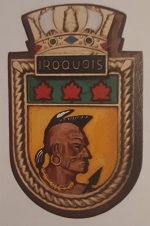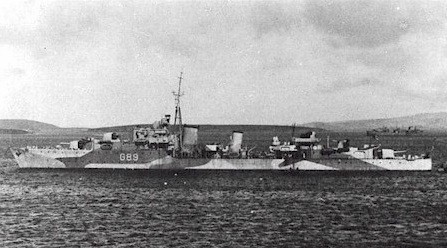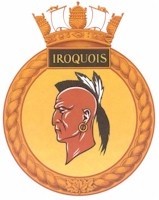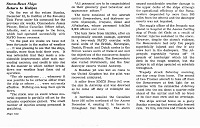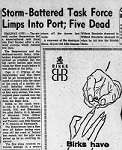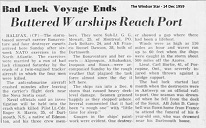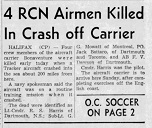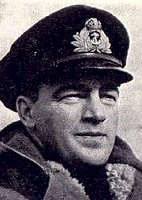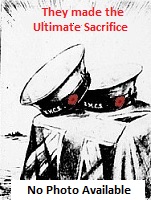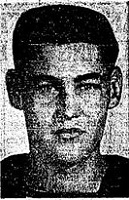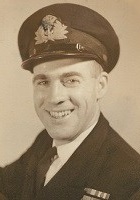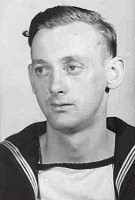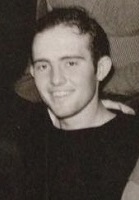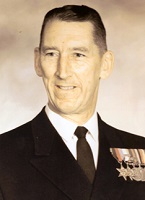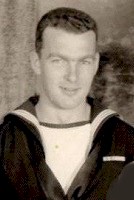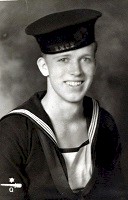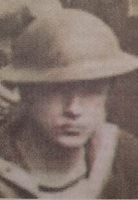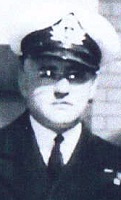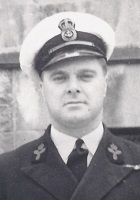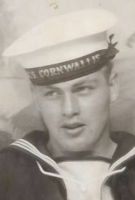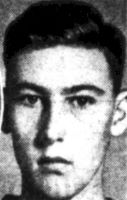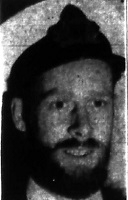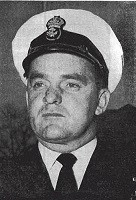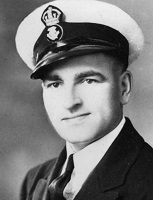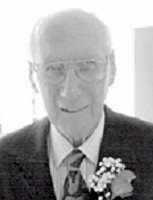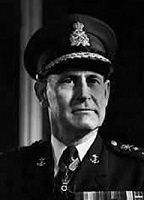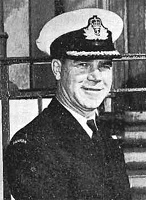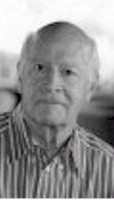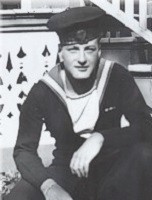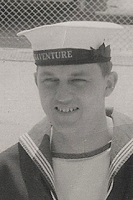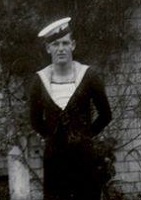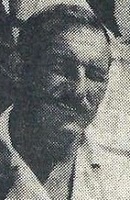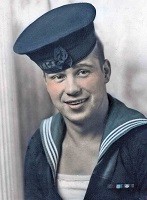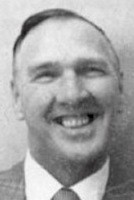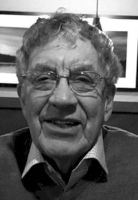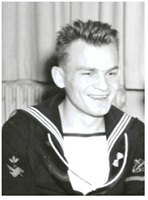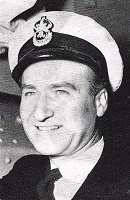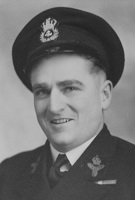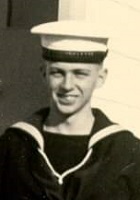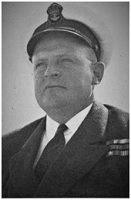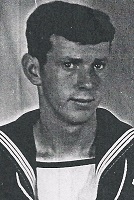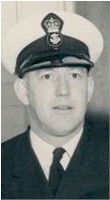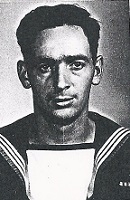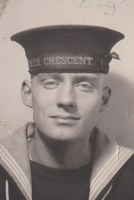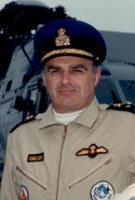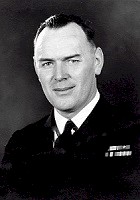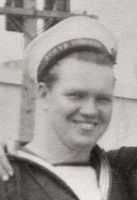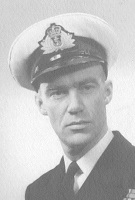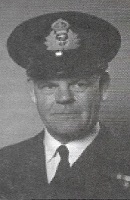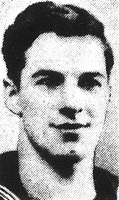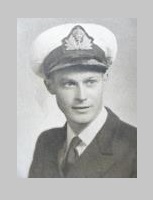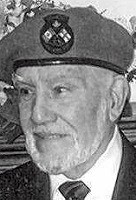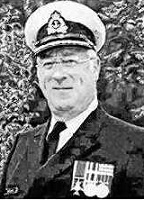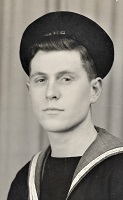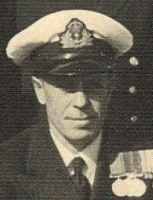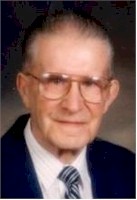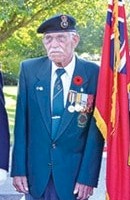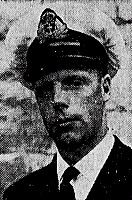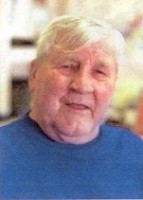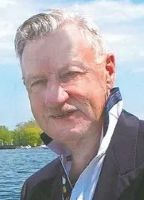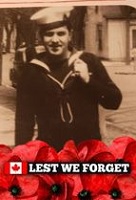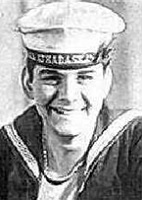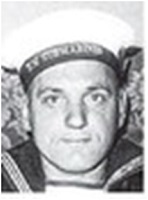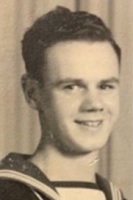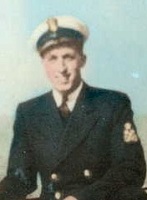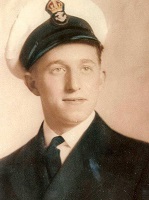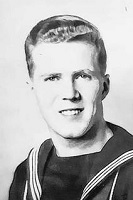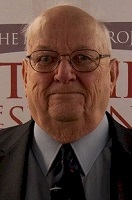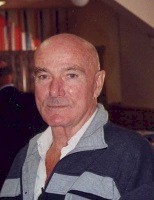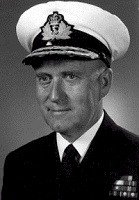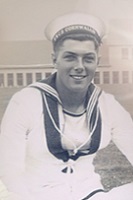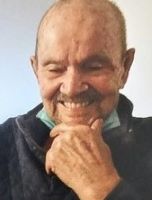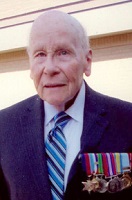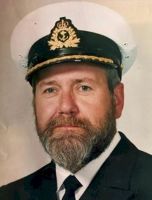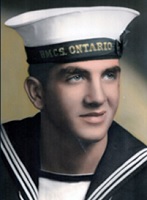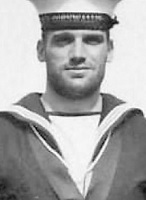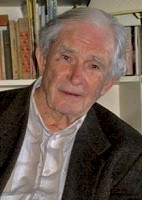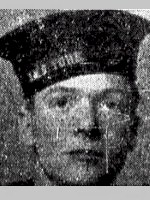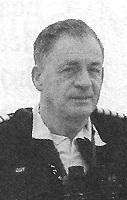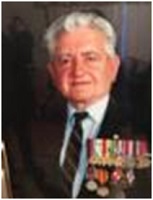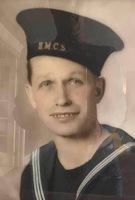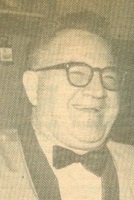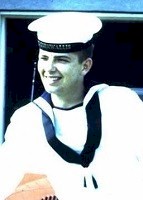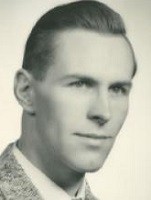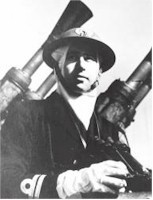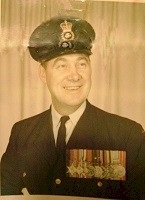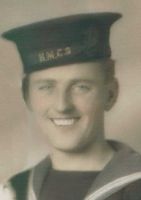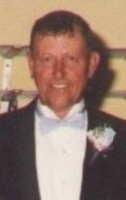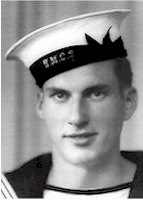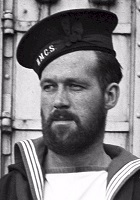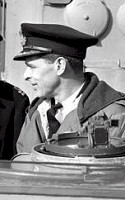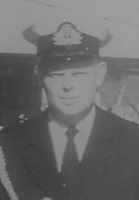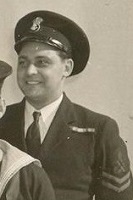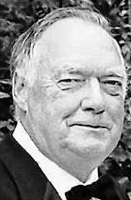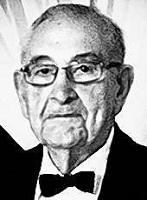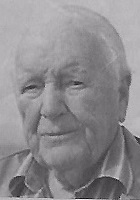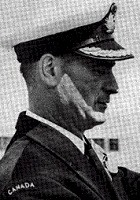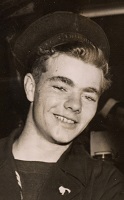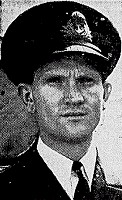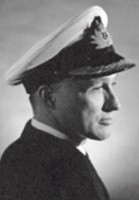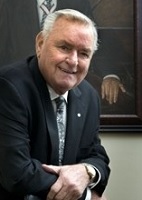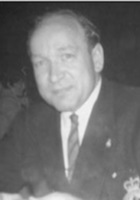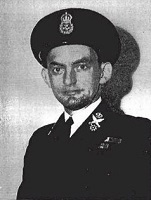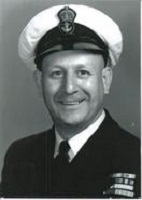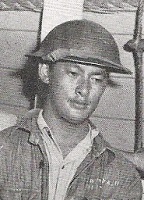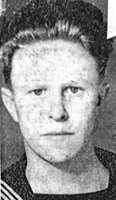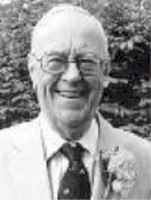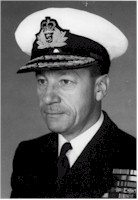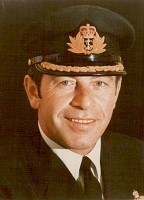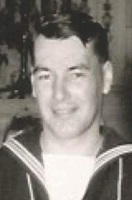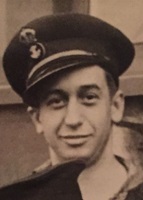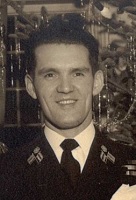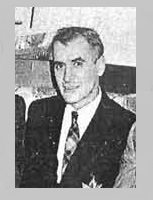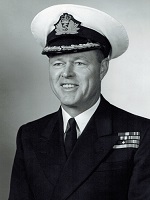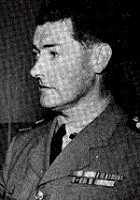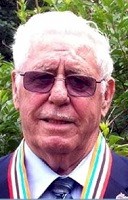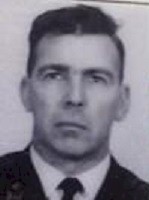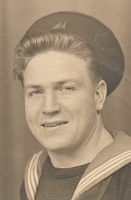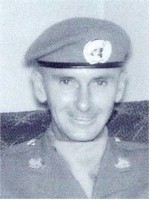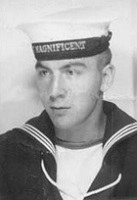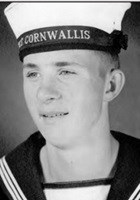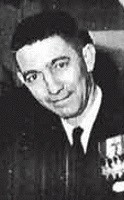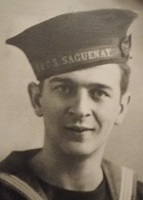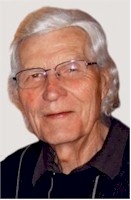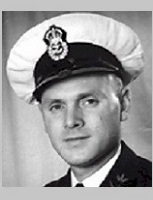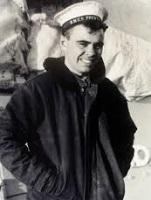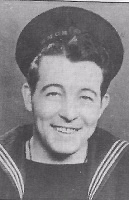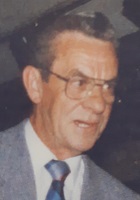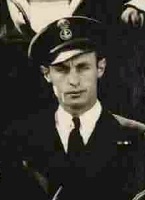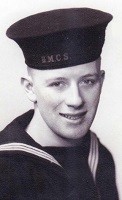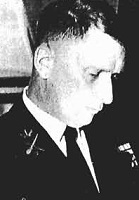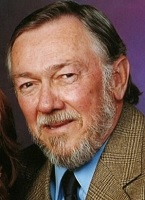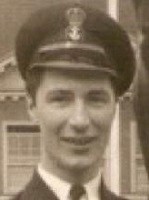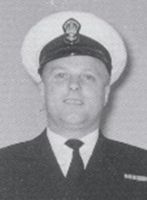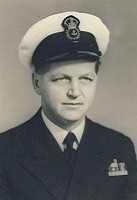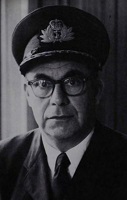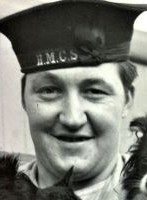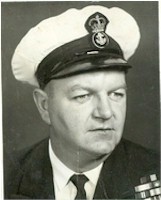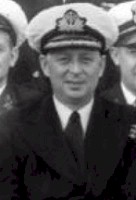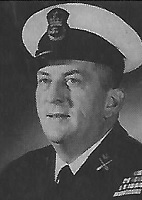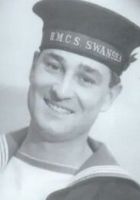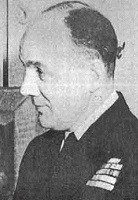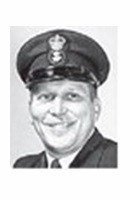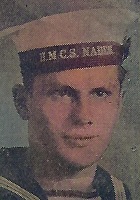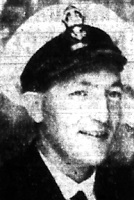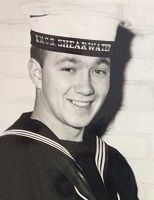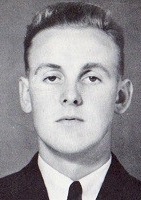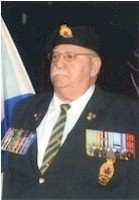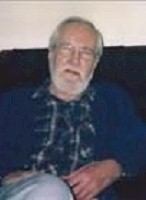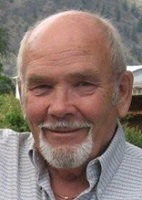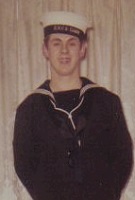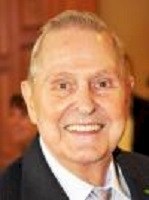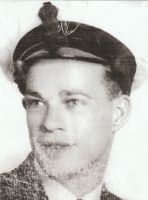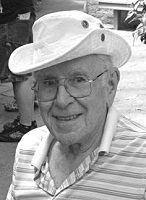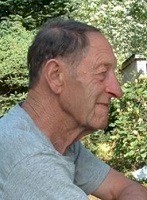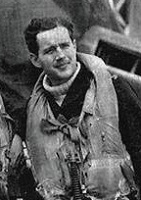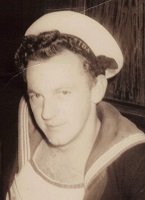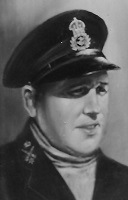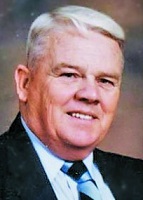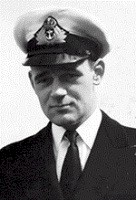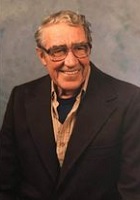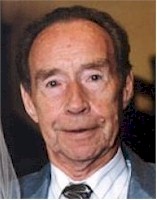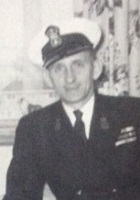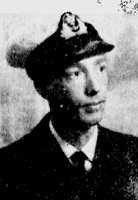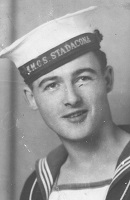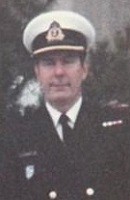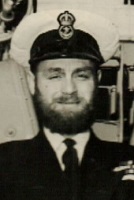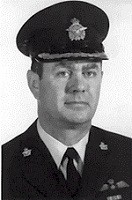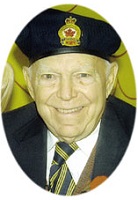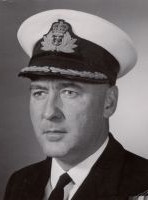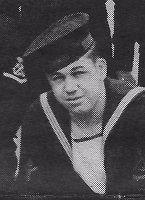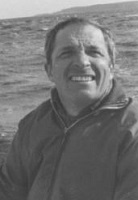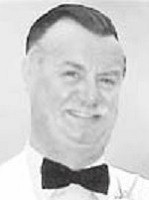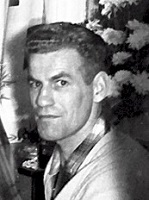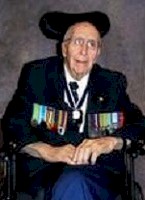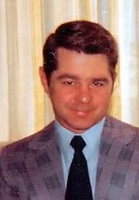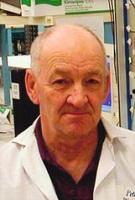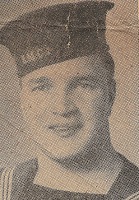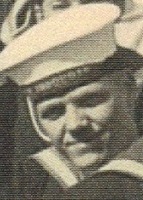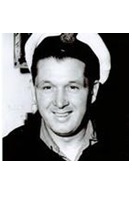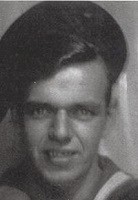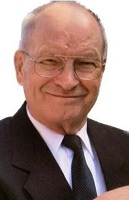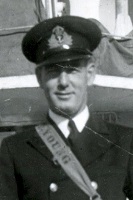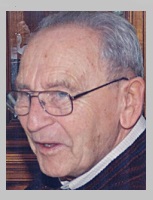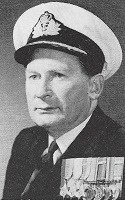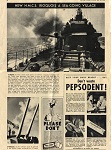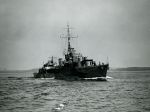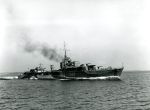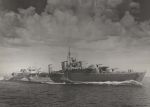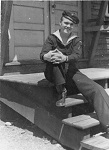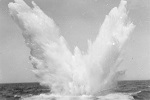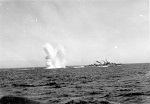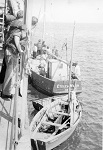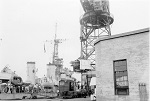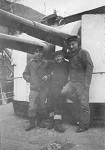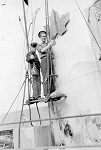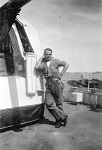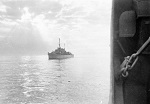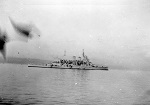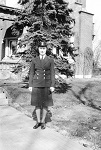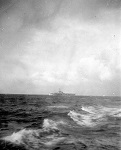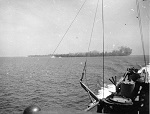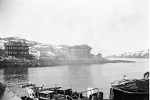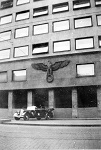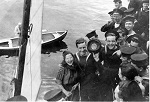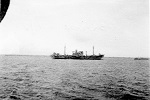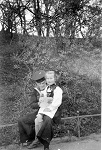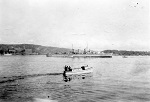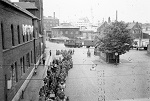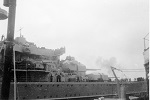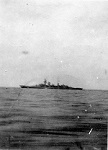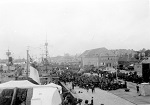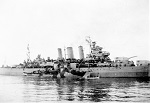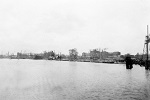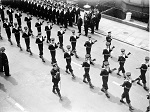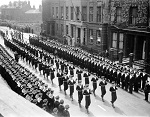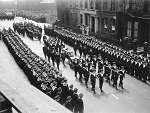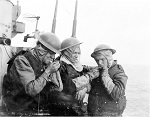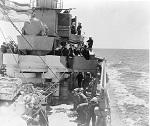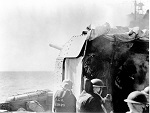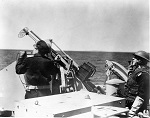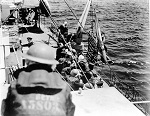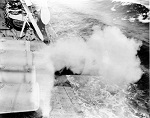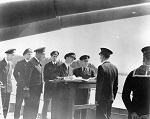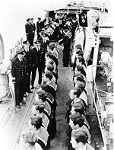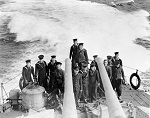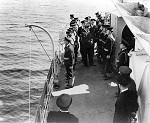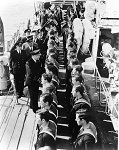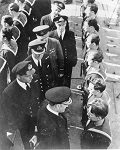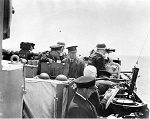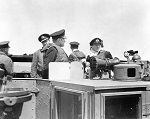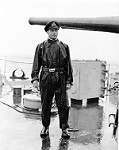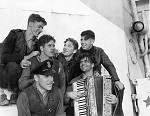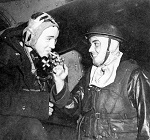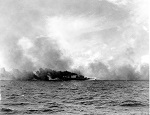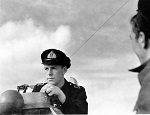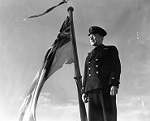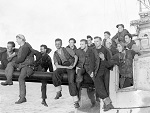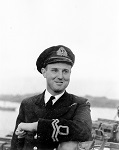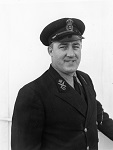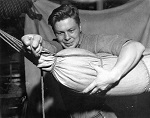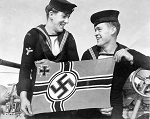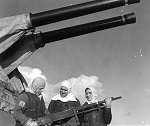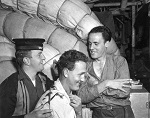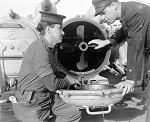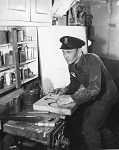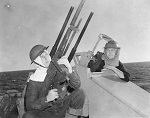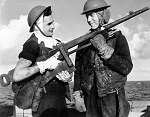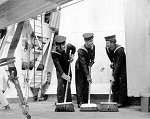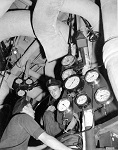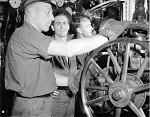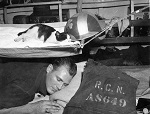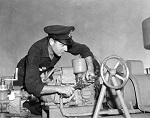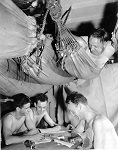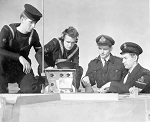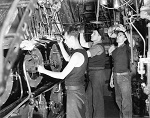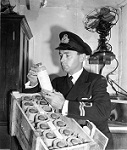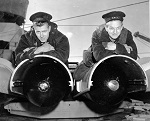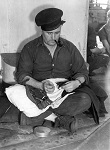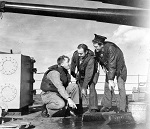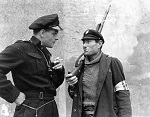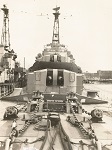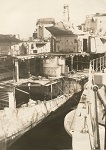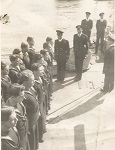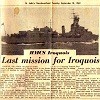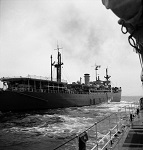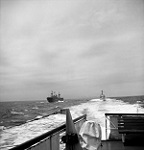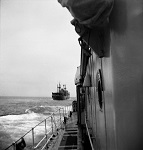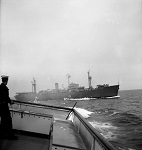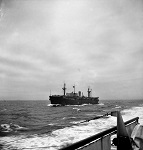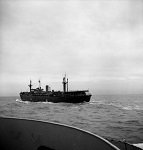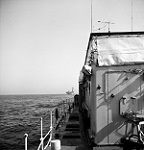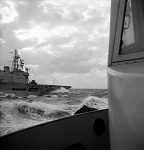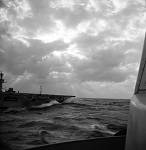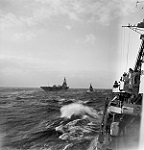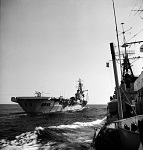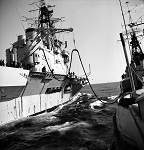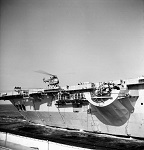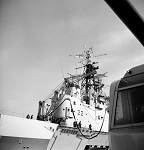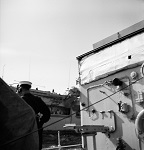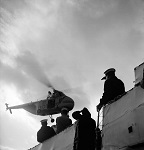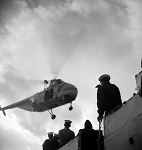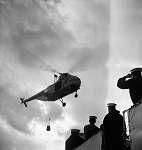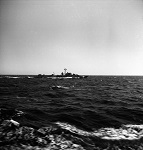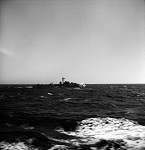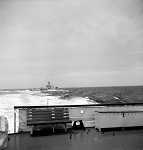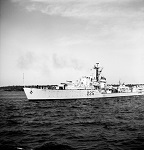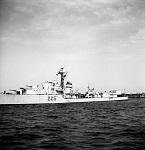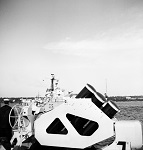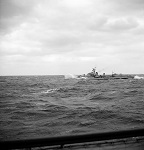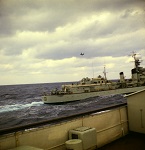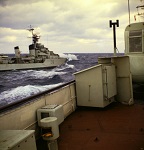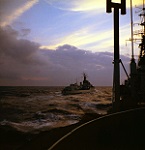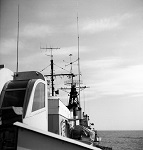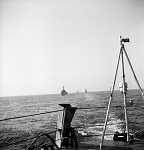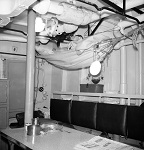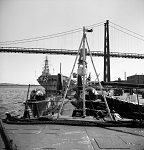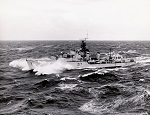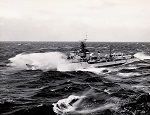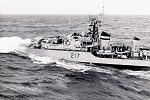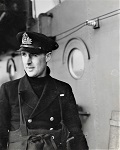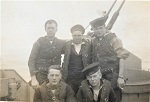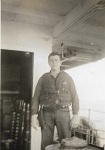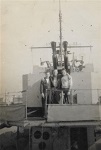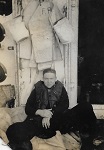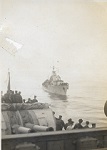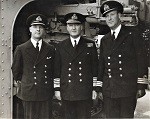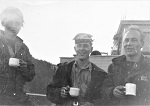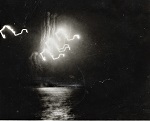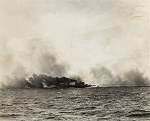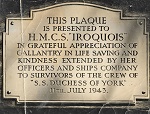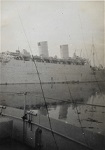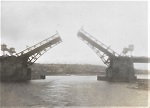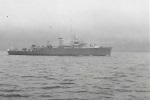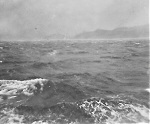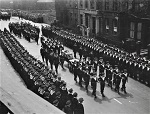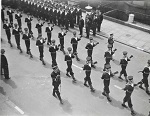|
HMCS IROQUOIS G89 / 217
Tribal Class Destroyer
The first of the Canadian Tribals to commission, she did so at Newcastle-on-Tyne, on 30 Nov 1942. IROQUOIS was assigned to the 3rd Flotilla, Home Fleet, but proved to have structural flaws and was not fully operational until 30 Jan 1943. On a quick round trip to Canada in Mar 1943 she incurred weather damage that kept her under repairs at Plymouth until early Jun 1943, following which she was employed on Gibraltar convoys. In Jul 1943 three troopships she was escorting to Freetown were attacked by German aircraft 300 miles off Vigo, Spain, and two were sunk, IROQUOIS rescuing 680 survivors from the Duchess of York. IROQUOIS then spent several months escorting Russian convoys. In Feb 1944, she arrived at Halifax for a refit, returning to Plymouth early in Jun 1944 to join the 10th Flotilla for invasion duties. After D-Day she carried out patrols in the Channel and the Bay of Biscay, and for some months escorted capital ships and troopships in U.K. coastal waters. She rejoined the Home Fleet at Scapa Flow in Mar 1945. On 16 Apr 1945, HMCS HAIDA G63, HMCS HURON G24 and HMCS IROQUOIS G89 departed Clyde with convoy JW.66 for Kola Inlet; arriving at Kola Inlet on 25 Apr 1945. They departed Kola Inlet for Clyde with convoy RA.66 on 29 Apr 1945. On 29 Apr 1945 HMCS HAIDA G63 and HMCS IROQUOIS were G89 attacked by U-427 (Oblt Karl-Gabriel Graf von Gudenus). The attack resulted in near misses by U-427. They arrived at Clyde on 08 May 1945. Following D-Day, she sailed to Oslo as an escort to Crown Prince Olaf, who was returning to liberated Norway. Shortly afterward she visited Copenhagen, whence she escorted the German cruisers PRINZ EUGEN and NURNBERG to Kiel for their formal surrender. On 04 Jun 1945 she left Greenock with HAIDA and HURON, arriving at Halifax on 10 Jun 1945.
The end of the Pacific war brought a halt to her tropicalization refit, and IROQUOIS was paid off on 22 Feb 1946. The following year she began a long refit and on 24 Jun 1949, was re-commissioned as a cadet training ship.
IROQUOIS completed 3 tours of duty in the Korean theatre. During her first tour, on October 2, 1952, IROQUOIS was making a daylight interdiction bombardment on a coastwise stretch of the main North Korean railway line when she received fire from the shore battery. A shell hit “B” gun deck and killed LCdr Quinn and AB Baikie instantly. AB Burden was critically wounded and died several hours later.
The following members of IROQUOIS were wounded in action on 02 Oct 52: Adam, Aimee, A.B., Berggrenn, Waldo, A.B., Dynna, Gilbert, A.B., Fortin, Emilien, MiD, P.O., Gaudet, Joseph, A.B., Jamieson, Gerald, DSM, P.O., Jodoin, Edwin, A.B., Moslin, Edward, P.O., Riley, Eugene, A.B., Wrigley, Walter, A.B. (Source: Korean Veterans Association of Canada)
HMCS IROQUOIS' tours in Korea
1st Tour: Departed Halifax: 21 Apr 1952 // Arrived in Op Area: 12 Jun 1952 // Departed Op Area: 26 Nov 1952 // Arrived in Halifax: 08 Jan 1953 2nd Tour: Departed Halifax 29 Apr 1953 // Arrived in Op Area: 18 Jun 1953 // Departed Op Area: 01 Jan 1954 // Arrived in Halifax: 10 Feb 1954 * 3rd Tour: Departed Halifax: 01 Jul 1954 // Arrived in Op Area: 22 Aug 1954 // Departed Op Area: 26 Dec 1954 // Arrived in Halifax: 19 Mar 1955 *
* After both her 2nd and 3rd Korean War tours, IROQUOIS returned to Canada via the Suez Canal thus circumnavigating the globe. Following her Korean tours, she returned to her training role.
In Nov/Dec 1959, during a 6-week deployment that included a NATO Exercise, HMCS BONAVENTURE, in company with HMCS ALGONQUIN, HMCS IROQUOIS, HMCS SIOUX and HMCS ATHABASKAN encounter a major storm that battered the squadron.
Four newspaper articles on the Nov/Dec 1959 deployment during which 5 RCN sailors died.
On 30 Jul 1962, the RCN sent the 3rd Destroyer Escort Squadron (Atlantic), under Capt. Gordon Edwards, on a good will / work up tour. The squadron consisted of HMCS SIOUX 225, HMCS HURON 216 and HMCS IROQUOIS 217 (as flagship). The ships sailed from Halifax NS to Bermuda and then on to Jamaica, arriving on 05 August 1962. The squadron joined a large fleet of naval vessels already assembled, as all Royal Navies and the United States Navy, had sent "good will" ships of various classes to Jamaica. In essence, it served to form one of the largest allied fleets to be assembled since WW II, and spent six days in Jamaica celebrating their independence from Briton which occurred on 06 Aug 1962. The squadron then sailed back to Bermuda before heading to Prince Edward Island to par-take in their official Lobster Festival. From PEI the squadron returned to Halifax for fuel and provisions, and again departed for Bermuda. From Bermuda it was onto Trinidad & Tobago to take part in their independence celebrations.
Shortly after entering the Caribbean Sea, the fresh water evaporator broke down and the Admiralty in Halifax was advised, and a replacement requested. This was easier said than done. HMCS IROQUOIS was a WWII Tribal class Destroyer, built in the UK in 1941. Although some spares were on hand in Halifax, an evaporator was not one of them. A request was sent to the Royal Navy in Britain, and they in turn advised that they could supply. When IROQUOIS reached Port of Spain, she received the replacement evaporator. The unit was brought onboard, still packed in its original crate. There was the usual adornment of numbers and code letters printed on the wooden crate. What caught everyone's eye however was the name printed on the crate in block letters "HMS HOOD" Apparently not all of the spares for Hood were disposed of. The unit was identical and fitted nicely, but not everyone was happy. Some of the older members of the crew (veterans of the Battle of the Atlantic) saw it as an "omen". They predicted it was the end of the IROQUOIS. IROQUOIS departed Port of Spain and headed for Bermuda again.
From Bermuda, the Squadron proceeded to Newfoundland where on 12 Sep to 17 Sep 1962, the Squadron took part in the 67th annual meeting of the National Council of the Navy League of Canada. While at St. John's, the squadron's actives included onboard entertainment of local dignitaries, day cruises for members of HMCS AVALON, HMCS CABOT and RCSCC Terra Nova and open house to the general public. Prior to leaving port IROQUOIS was advised to wear our "Paying off Pennant" upon leaving harbour, as this was to be her last port of call. On 24 Oct 1962, IROQUOIS was paid off at Halifax and placed in operation reserve (Moth balled) Point Edward Naval Station, Cape Breton N.S. She was broken up at Bilbao, Spain, in 1964.
She never sailed again ... OMEN?
Photos and Documents Ship's company photos The Ship's Bell
The Biscay Blockage: Operation KINETIC Twelve Feet From Death
West About - A Pictorial Record of HMC Ships Huron and IROQUOIS Under U.N. Command 1954 - 1955
Commanding Officers
They shall not be forgotten A
B
C
D
E
F
G
H
I
J
K
L
M
N
O
P
Q
R
S
T
W
Y
Former Crew Members
K3 = Crew list from 3rd Korean war deployment - 1954-1955
Photos and Documents
(JVW277) HMCS IROQUOIS G89 A Seagoing Village (JVW278) HMCS IROQUOIS G89 Joins Canada's Fighting Fleet From the collection of J. Vincent Wesley, CPO, RCNVR Courtesy of Marilynn Taylor
(IRQ001-IRQ002) HMCS IROQUOIS G89 departing Halifax, NS (IRQ003) HMCS IROQUOIS G89 // DND / RCN photo Negative # L0131A // This is the same photo as IRQ002, but the wartime censor has smudged out her pendant number and changed the background to hide the location (IRQ004) HMCS IROQUOIS G89 // RCN Photo # LX-0126-R // Courtesy of the Comox RCAF Museum // This photo is next in the sequence of IRQ001 and IRQ002 (IRQ005) HMCS IROQUOIS G89 // From the collection of Cdr Bernard Summers Lake, RCN // Courtesy of Barry Lake
(IRQ006) Article on HMCS IROQUOIS G89 joining the Home Fleet after a round trip to Canada (IRQ007) HMCS IROQUOIS G89 // Courtesy of Dave Shirlaw (IRQ008) Man Overboard - Ernest G. Edward fell over board while serving in HMCS IROQUOIS during the Second World War. He was rescued. // Courtesy of Terrance Edwards (IRQ009) HMCS IROQUOIS G89 covered in ice in the North Atlantic // Courtesy of Bill Gard (IRQ010) Jacket patch for HMCS IROQUOIS G89 // Courtesy of Terrance Edwards // From the book Designs of Distinction : In his book "Tribal Captain", in a photograph between pp 100 and 101, Edward TG Madgwick, retired Captain, RCN, says he produced this design as 1st Lieutenant of IROQUOIS when she commissioned. the design came from a book on the IROQUOIS nation found in an English library. The design became a jacket patch in 1945. Minus the rope shield, this design appeared on the ship's stationary, but in black and white.
(IRQ014) IROQUOIS SHOWS HER TEETH // Newspaper article on HMCS IROQUOIS G89 sinking German Flak ship off France // Crow's Nest Newspaper - Nov 1944 // Historical note: This action happened on 23 Aug 1944 as part of the Battle of Audierne Bay. IROQUOIS sank a flak ship by gunfire. This photo is of a German minesweeper being torpedoed by IROQUOIS, not the sinking of the Flak ship as indicated in the news article. (IRQ015) ERA Arthur Kyle on HMCS IROQUOIS G89 with the ship's mascot, Kipper // Courtesy of Tim Kyle (IRQ016) Newspaper article on SLt J.M.Dowler, HMCS IROQUOIS // The Winnipeg Evening Tribune, 06 Apr 1943 (IRQ017) Sailors or HMCS IROQUOIS write letters home // Crow's Nest newspaper - Dec 1944 (IRQ018) Two sailors on HMCS IROQUOIS display a wartime souvenir // Sto Jules Barron and Sto Joseph Harold // Crow's Nest newspaper - Dec 1944
(RTL-LRB001) HMCS IROQUOIS 's gun crew at work (RTL-LRB002) Unknown allied sailor, photo taken by crew member of HMCS IROQUOIS (RTL-LRB003) Captain F.L. Houghton, RCN, Commanding Officer HMCS PRINCE ROBERT from 22 June to 31 December 1942 visiting HMCS IROQUOIS. Another photo taken at the same time has a caption of Capt F.L. Houghton onboard HMCS PRINCE ROBERT (RTL-LRB004) Polish destroyer ORP PIORUN, originally laid down as the N class destroyer HMS NERISSA and transferred to the Polish Navy while still under construction. Photo taken from HMCS IROQUOIS, date/place unknown (RTL-LRB005) The water astern of HMCS IROQUOIS vapourizes from the explosion of the destroyers depth charges
(RTL-LRB006) HMCS HURON dropping depth charges (RTL-LRB007) On August 26 1944, HMCS IROQUOIS met a small boat from Ile d'Yeu, a small channel Island. Onboard was the local school teacher who stated the Germans had left the Channel Island the day before. In their retreat the post office, radar installations and lighthouse had been destroyed, nineteen citizens and the mayor were also taken as prisoners. IROQUOIS sent a shore party ashore with supplies, food, chocolate, cigarettes and signalling equipment. The IROQUOIS sailors stepped ashore to much celebration. Remaining on the island overnight, the next morning there was a service at the graves of allied airmen, the sailors returned to IROQUOIS with details of enemy positions, minefields and shore defences. The locals also showered the sailors with flowers and a large iced cake, for IROQUOIS was the first allied force to arrive on the island (see also RTL-LRB026) (RTL-LRB008) Unknown Canadian Tribal class destroyer receiving a new gun and turret alongside in Plymouth, Possibly HMCS HAIDA in August 1944 (RTL-LRB009) HMCS IROQUOIS'S sea boat returns to the destroyer after sending a shore party to the liberated Channel Island of Ile d'Yeu on 27 August 1944. The grateful islanders showered the RCN sailors with flowers (visible on deck) and cake, being the first allied force to arrive on the island after the Germans had retreated. IROQUOIS'S shore party brought much needed food and supplies to the island residents (RTL-LRB010) Visitors to HMCS IROQUOIS, unknown date/location
(RTL-LRB011) HMCS IROQUOIS' Maple Leaf on her funnel gets a fresh coat of paint in 1944 (RTL-LRB012) Two HMCS IROQUOIS sailors standing sentry with the Lanchester sub-machine gun, with 50 round magazines and long bayonets in 1945. Unknown location (RTL-LRB013) HMCS IROQUOIS'S whaler has been smashed to pieces in the davits during severe North Atlantic storm in early 1943 (RTL-LRB014) Unidentified RCN sailor onboard HMCS IROQUOIS. "The Some" written on back of photo (RTL-LRB015) HMS APOLLO, Manxman minelayer, carrying the Crown Prince Olav of Norway and the exiled Norwegian government, approaches HMCS IROQUOIS on 13 May 1945 in Oslo, Norway
(RTL-LRB016) HMS RENOWN in Rosyth, Scotland. Photo taken from HMCS IROQUOIS, unknown date (RTL-LRB016) Lancaster bomber, unknown location/date. Writing on the back of the photo, "Sqd 419, "Q for Queenie" that they were (last or lost) in 12 miles north east of Essen." Webmaster's note: While the back of the photo indicates the plane is "Q" for Queenie, she was not lost near Essen. "Q" for Queenie, piloted by Flight Lieutenant Peter S Isaacson, DFC, DSM, departed from Britain 22 May 1943 and arrived in Australia 04 Jun 1943 via the Atlantic, Canada and the Pacific. Her tour came to an end on 26 Oct 1943 when a wind shift caused a crash landing of "Q" for Queenie at Evans Head in Northern New South Wales. It is possible the plane in the photo was Lancaster KB776 that was lost while over the target near Essen on 24 May 1944 (RTL-LRB018) Unidentified Wren of the WRCNS, date/location unknown (RTL-LRB-019) HMS INDEFATIGABLE underway, photo taken from HMCS IROQUOIS (RTL-LRB020) HMCS IROQUOIS in Belfast during the Second World War, unknown date
(RTL-LRB021) HMCS IROQUOIS making smoke and dropping depth charges (RTL-LRB022) HMCS IROQUOIS with HMShips MAURITIUS and URSA steaming at 32 knots and laying smoke screen to evade fire from shore batteries off the west coast of France on 22 August 1944. IROQUOIS and MAURITIUS had been straddled by shells from the Gironde Shore Battery (RTL-LRB023 / RTL-LRB-024) View of Polyarnoe, Russia from HMCS IROQUOIS during on of her stops while escorting Arctic convoys in late 1943 or early 1944 (RTL-LRB025) Gestapo Headquarters in Oslo, Norway in May 1945. Photo taken by RCN Sailor Lynford Bourne of HMCS IROQUOIS after the destroyer had escorted the exiled Norwegian Government to Oslo on 12 May 1945
(RTL-LRB026) On August 26 1944, HMCS IROQUOIS met a small boat from Ile d'Yeu, a small channel Island. On board was the local school teacher who stated the Germans had left the Channel Island the day before. In their retreat the post office, radar installations and lighthouse had been destroyed, nineteen citizens and the mayor were also taken as prisoners. IROQUOIS sent a shore party ashore with supplies, food, chocolate, cigarettes and signalling equipment. The IROQUOIS sailors stepped ashore to much celebration. Remaining on the island overnight, the next morning there was a service at the graves of allied airmen, the sailors returned to IROQUOIS with details of enemy positions, minefields and shore defences. The locals also showered the sailors with flowers and a large iced cake, for IROQUOIS was the first allied force to arrive on the island (see also RTL-LRB007) (RTL-LRB027) German merchant ship in Copenhagen in May 1945. Photo taken from HMCS IROQUOIS (RTL-LRB028) A local child poses with a Canadian sailor from HMCS IROQUOIS as he writes a letter while in Oslo, Norway in May 1945 (RTL-LRB029) Several Catherine class minesweepers in Oslo, Norway in May 1945. HMS GRECIAN (J352) is facing. Photo taken by Lynfourd Boune in HMCS IROQUOIS
(RTL-LRB031) A large group of German Prisoners-of-War in Copenhagen, Denmark in May 1945. Photo taken by Lynford Boune while his ship HMCS IROQUOIS was in the city following the surrender of German forces (RTL-LRB032 - RTL-LRB035) PRINZ EUGEN, German Navy's Admiral Hipper class cruiser, surrendered at Copenhagen, Denmark in May 1945. Photos taken from HMCS IROQUOIS, who formed part of the Allied escort for the cruiser and the Leipzig class cruiser NURMBERG to Wilhelmshaven, Germany for their formal surrender to the Allies
(RTL-LRB036) Admiral Hipper class cruiser, PRINZ EUGEN from HMCS IROQUOIS. The IROQUOIS is escorting PRINZ EUGEN and NURMBURG from Copenhagen, Denmark to Wilhelmshaven, Germany for the formal surrender. The two German cruisers and escort force departed Copenhagen on 27 May 1945, arriving the next day (RTL-LRB037) Admiral Hipper class cruiser, PRINZ EUGEN arriving at the locks at Wilhelmshaven, Germany from HMCS IROQUOIS (foreground) on 28 May 1945 (RTL-LRB038) Under the watchful eyes of armed RN sailors, thousands of German Prisoner-of-War have been gathered at the harbour in Wilhelmshaven, Germany on 28 May 1945. Photo taken from HMCS IROQUOIS (foreground) on her arrival in the German port after escorting the German cruisers PRINZ EUGEN and NURMBURG from Copenhagen, Denmark for their formal surrender to Allied forces (RTL-LRB039) HMS DEVONSHIRE with a surrendered German M class mine sweeper alongside in Oslo, Norway. Photo taken from HMCS IROQUOIS on 12 May 1945. The RN cruiser is flying the Norwegian flag from her aft mast. IROQUOIS and DEVONSHIRE provided escort to HMS APOLLO carrying the Crown Prince Olav of Norway and the exiled Norwegian government to Oslo (RTL-LRB040) View of dockyard at Wilhelmshaven, Germany from HMCS IROQUOIS as the Canadian destroyer arrived in the German city on 28 May 1945
HMCS IROQUOIS ships company provides the Honour Guard during the funeral of Captain, Frederic John Walker, RN, CB, DSO & Three Bars in Liverpool on 11 July 1944. The funeral was attended by more than 1000 people, RN ratings carried his body on a gun carriage, escorted by sailors from IROQUOIS, through the streets of Liverpool to the dockyard. Walker's body was transferred to HMS HESPERUS for burial at sea. Captain Walker was the Commanding officer of HMS STARLING and Senior Officer of the 2nd Support Group. He was the most successful anti-submarine warfare commander during WWII and responsible for developing many of the tactics used against the U-Boats during the Battle of the Atlantic
(RTL-LRB041) Commander J.C. Hibbard, Commanding Officer of IROQUOIS is on the left, with Chief S.M. Saunders on the right of the ships company. (RTL-LRB042)HMCS IROQUOIS ships company provides the Honour Guard during the funeral of Captain, Frederic John Walker, RN, CB, DSO & Three Bars in Liverpool on 11 July 1944 (RTL-LRB043) Royal Navy ratings carry the body of Captain, Frederic John Walker, RN, CB, DSO & Three Bars, on a gun carriage on 11 July 1944
(RTL-LRB045) Unidentified sailors on HMCS IROQUOIS (RTL-LRB046) Sailors at their action stations on an AA gun taking a smoke break on HMCS IROQUOIS (RTL-LRB047) Crew of HMCS IROQUOIS at action stations (RTL-LRB048) HMCS IROQUOIS firing her 4.7-inch guns (RTL-LRB049) HMCS IROQUOIS firing her 4.7-inch guns
(RTL-LRB050) Gun crew loading the 4.7-inch guns on HMCS IROQUOIS (RTL-LRB051) AA gun crew on HMCS IROQUOIS (RTL-LRB052) Unidentified sailor being hoisted aboard HMCS IROQUOIS (RTL-LRB053) HMCS IROQUOIS firing a torpedo (RTL-LRB054) X.O.'s requestmen being held on HMCS IROQUOIS
(RTL-LRB055) Sailors on HMCS IROQUOIS fallen in and being inspected (RTL-LRB056) Sailors on the quarterdeck of HMCS IROQUOIS (RTL-LRB057 - RTL-LRB059) Crew of HMCS IROQUOIS being inspected by unknown flag officer
(RTL-LRB060 - RTL-LRB061) Unknown flag officer on the bridge of HMCS IROQUOIS (RTL-LRB062) Unknown officer by one of HMCS IROQUOIS'S 4.7-inch gun (RTL-LRB063) A bit of music and singing on HMCS IROQUOIS (RTL-LRB065) Gun crew having a smoke break on HMCS IROQUOIS
(RTL-LRB066) Unknown cruiser making smoke (RTL-LRB067) Unknown officer on the bridge of HMCS IROQUOIS (RTL-LRB069) Unknown Chief Petty Officer by the Ensign on HMCS IROQUOIS (RTL-LRB070) Sailors sitting on a 4.7-inch gun on HMCS IROQUOIS (RTL-LRB071) Sailors conducting maintenance on one of the torpedo tubes on HMCS IROQUOIS
(RTL-LRB072) Unknown officer of the bridge of HMCS IROQUOIS (RTL-LRB073) Unknown Torpedo Cox'n on HMCS IROQUOIS (RTL-LRB074) Thomas Manson on HMCS IROQUOIS securing his mic for stowage (RTL-LRB075) Unknown sailors on HMCS IROQUOIS holding an Second World War German naval flag (RTL-LRB076) Unknown sailors on HMCS IROQUOIS holding a dummy wooden machine gun
(RTL-LRB077) The ship's barber at work on HMCS IROQUOIS (RTL-LRB078) Inspecting a torpedo loading in one of the torpedo tubes on HMCS IROQUOIS (RTL-LRB079) Unknown CPO Shipwright at work on HMCS IROQUOIS (RTL-LRB080) Unknown sailor by AA mount on HMCS IROQUOIS holding a dummy wooden machine gun (RTL-LRB081) Unknown sailors on HMCS IROQUOIS posing with dummy wooden machine gun
(RTL-LRB082) Unknown sailors on HMCS IROQUOIS posing with brooms (RTL-LRB083) Unknown Petty Officers in the boiler room of HMCS IROQUOIS (RTL-LRB084) Unknowns stokers in the boiler room of HMCS IROQUOIS (RTL-LRB085) Unknown sailor on HMCS IROQUOIS catching some sleep while the ship's mascot sleeps above in its own hammock (RTL-LRB086) Unknown Chief working on some equipment on HMCS IROQUOIS
(RTL-LRB087) Cramped life in a mess deck on HMCS IROQUOIS (RTL-LRB088) L-R: A leading signalman, Leading Telegraphist, Lieutenant and Petty Officer posing with a radio on the bridge of HMCS IROQUOIS (RTL-LRB089) Stokers in the boiler room of HMCS IROQUOIS (RTL-090) Unknown Lt inspecting a delivery of some sort on HMCS IROQUOIS (RTL-091) Unknown sailors posing on the torpedo tubes of HMCS IROQUOIS
(RTL-LRB092) Unknown sailor on HMCS IROQUOIS mending his uniform (RTL-LRB093) Unknown sailors posing for photo on HMCS IROQUOIS (RTL-LRB094) Unknown officer, presumably off IROQUOIS, talking with allied fighter
From the collection of Lynford Bourne, RCNVR Courtesy of the Roger Litwiller collection and the Battle of Atlantic Place
(AM19) Fo'c's'le of HMCS IROQUOIS - photo taken from by the bull ring (AM19a) HMCS MICMAC under repair after being rammed by SS Yarmouth County on 16 Jul 1947. Photo taken from HMCS IROQUOIS (AM20) Divisions on HMCS IROQUOIS
From the collection of CPO1 Archie MacArthur, RCN
Courtesy of Colleen Coons
Unknown sailor off HMCS IROQUOIS G89 - circa 1948 From the collection of Ivan Chamberlain Courtesy of Dave Chamberlain
Photos on and from HMCS IROQUOIS 217
(CM01-CM05) HMCS Cape Scott 101 - Photos taken from HMCS IROQUOIS
(CM06) HMCS Cape Scott 101 - Photo taken from HMCS IROQUOIS (CM08-CM10) HMCS BONAVENTURE - Photos taken from HMCS IROQUOIS
(12-15) HMCS IROQUOIS approaching and conducting a RAS with HMCS BONAVENTURE (CM14) Unknown destroyer astern of IROQUOIS and BONAVENTURE as man overboard and plane guard (CM15) Helo taking off from BONAVENTURE to deliver mail during RAS with IROQUOIS
(CM16-CM18) HMCS IROQUOIS conducting a RAS with HMCS BONAVENTURE (CM18) RAS complete, IROQUOIS pulls away from BONAVENTURE
(CM19-CM21) Helo delivering mail to HMCS IROQUOIS
(CM22-CM26) HMCS SIOUX 225
(CM27) HMCS SIOUX 225 (CM28) HMCS HURON 216 (CM29-CM31) HMCS ATHABASKAN 219 - 1961
(CM32) HMCS IROQUOIS, Starboard side looking forward from after 3"50 (33) Destroyers in formation astern of HMCS IROQUOIS (CM34-CM35) Supply Branch Aft Mess Deck in HMCS IROQUOIS - 1961 (CM36) HMCS BONAVENTURE and an unknown submarine secured alongside in Halifax astern of HMCS IROQUOIS
HMCS IROQUOIS 217 Taken from the flight deck of HMCS BONAVENTURE - 1962
Courtesy of Claus Mathes
(RD16) Lt Madgwick on HMCS IROQUOIS G89 (RD17) Sailors on HMCS IROQUOIS G89 Russell Dewe, back, 1st on left - Eric Snell, back, centre. Two of other sailors in the photo are B. Evasik and Robert Willis though it is not known which sailors they are in the photo (RD18) Russell Dewe on HMCS IROQUOIS G89 (RD19) Russell Dewe (centre) other two sailors unknown on HMCS IROQUOIS G89 (RD20) Unknown sailor on HMCS IROQUOIS G89
(RD21) HMCS IROQUOIS G89 (foreground) at Scapa Flow with unknown destroyer coming alongside (RD22) L-R: Cdr Harry Dewolf, Adm Fraser (Royal Navy) and, Cdr James Calcutt Hibbard on HMCS IROQUOIS G89 (RD23) Russell Dewe (centre) and two unknown shipmates (RD24) Starshells during night action in the Bay of Biscay (RD25) Unknown ship making smoke screen - photo taken from HMCS IROQUOIS who was also laying smoke
(RD26) Plaque presented to HMCS IROQUOIS G89 in appreciation of her rescuing 680 survivors from the troopship SS DUCHESS OF YORK that was sunk by German Aircraft on 11 Jul 1943 300 miles of Virgo, Spain (RD27) Unknown troop ship seen from HMCS IROQUOIS G89 (RD28) Drawbridge at unknown location (RD29) Unknown Algerine Class Minesweeper (RD30) Unknown coastline seen from HMCS IROQUOIS G89
(RD31) Funeral procession for Capt Walker of HMS STARLING - Jul 1944 (RD32) Honour guard from HMCS IROQUOIS G89 for the funeral of Capt Walker of HMS STARLING
From the collection of Russell James Dewe, AB, RCNVR
Courtesy of Robin Dewe
|
||||||||||||||||||||||||||||||||||||||||||||||||||||||||||||||||||||||||||||||||||||||||||||||||||||||||||||||||||||||||||||||||||||||||||||||||||||||||||||||||||||||||||||||||||||||||||||||||||||||||||||||||||||||||||||||||||||||||||||||||||||||||||||||||||||||||||||||||||||||||||||||||||||||||||||||||||||||||||||||||||||

